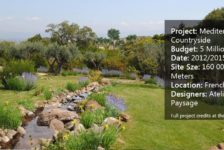Last week, we discussed a few different ways of ordering the materials you put in your portfolios. But today, I have another employer’s feedback to share with you.
As many of you know, I have been asking colleagues for their perspective. Each of them is in the position of doing the hiring and portfolio review for their respective firms. Our conversations are typed by me, approved or modified by the person interviewed, and posted here for you. It is through this process, that as much as possible, these are their words.
Scott Lewis of Scott Lewis Landscape Architecture generously shared with me his opinions about portfolios and the whole hiring process. He took a lot of time out of his busy schedule to share this information with me, and I very much appreciate it. Below you will find his input:
Q: “I know that there are a lot of recent graduates who haven’t been able to find work, but still want to do things that will keep them from being dismissed as candidates. What would you say to people who don’t have a lot of professional experience?”
Do you mean what should they emphasize on their résumé when they have been unable to find work, or whether to mention jobs they doing to pay bills while finding a position in the field?
If résumé only and no job yet, emphasize GPA, student awards, volunteer or internships that deal with the profession, such as ASLA or Habitat for Humanity, etc.
If question is about what to emphasize in non-field jobs, emphasize communication skills, people skills, and organizational skills. For example, in the cover letter one might state that while looking for a professional position, the applicant volunteered to assist in a community garden project, or volunteered on environmental education at a summer camp.
While looking for work, candidates can also:
- Do unpaid internships at a professional LA firm.
- Become aware of the current State and municipal codes in the area one is looking for work, in particular those relating to green building. For example, many cities in California are using the Green Points checklist for building permits, which is different than LEED.
- Get involved in professional organizations: ASLA, AIA, TCLF, etc.
- Learn plants. Most recent graduates have limited plant knowledge. If the candidate wants to focus on urban design, research the types of plants that will survive and thrive in an urban environment with little maintenance.
Q: “What do you need to see in order to hang on to someone’s information?”
A: I will keep materials on an applicant because of the tone of the cover letter, a graphically clean portfolio and examples of construction documents and details.
Q: “What is an automatic deal-breaker for you when you receive someone’s materials?”
A: Typos and incorrect grammar in the cover letter, overly-long cover letters and form cover letters. If a candidate cannot write a cover letter with proper grammar and spelling, that indicates a lack of attention to detail. Length: A cover letter should be one page and briefly introduce the candidate, why they are interested in our firm and how their skills/experience might be a good match. Content: A form cover letter that the candidate uses for all their contacts, regardless of the firm they are contacting, shows a lack of preparation and sensitivity to the individual design direction of the firm. Our firm does very little urban planning work, yet we have received material from candidates emphasizing their urban planning and analysis skills. That indicates the candidate has not researched our firm.
Q: “How has the flow of un-solicited applications changed lately?”
A: Has picked up in this year. More candidates are contacting us via email than with hard copy packages.
Making Contact:
- Never make a cold call.
- If at all possible, try to contact someone on the phone, not via email.
- Network to establish contacts – you will have a better chance of getting a return phone call if you can say that, for example “Susan Smith thought it would be a good idea for me to contact you because of my interest in habitat restoration, which I see was a focus of your project for the Middletown Creek Park”.
- Setting up an informational interview is often an effective way to get an introduction to a firm’s practice and to make contacts. Make it clear that you are not looking for a position, but that you are interested in the firm’s work (mention specific projects) and that you would appreciate the opportunity to have a 30 minute mtg. with a project manager or principal. Many firms are happy to talk about their work.
Cover letters and Thank you notes:
- Cover letter: Limit to one page and as brief as possble. Introduce yourself; give a brief statement about how you learned of the company (award, website, article, etc.) and what you want – an interview for an advertised position? An informational interview? Be specific. It should be a couple of paragraphs at most. Many cover letters are too long.
- Always send a thank you note after you have had an interview. The thank you note can be hand-written, typed, or via email. Written or typed will get noticed more.
Web-based Portfolios:
- I will seldom take the time to look at a web-based portfolio. I will not respond to an email that says ‘Hi, my name is ___ please go to my website at ____” because it’s obvious that person has not taken the time to research our firm and demonstrate why we should be interested in them.
- There is a danger in thinking that just because you built a website, that it will be seen.
Resumes:
- Limit the résumé to one page. Specify your education and experience. Travel is OK if associated with education or work.
- Do not include hobbies, languages (unless you are looking at an international firm), personal travel not related to education or work, or your reasons for entering the profession.
Content:
- Planning analysis studies are good because the graphics can be clean and bold. Large-scale conceptual drawings and style boards are also good things for entry level candidates to show.
- Good renderings are a plus, but don’t include hand drawings unless you can really draw.
- Understand that lower level positions include a lot of support work. Be prepared to show details, mini-sets of CD’s, etc. Know that this is the work you will be asked to do initially.
- I understand that it isn’t easy for entry level people to have a lot of work to show, but you can always go back to student projects and continue to develop them graphically or develop a construction document set based on a student project.
- If you are presenting work from project types other than those the company does, because that’s all you have, that is fine, but don’t neglect to acknowledge that you have at least looked at the company’s website.
- Student models (physical) are usually pretty rough. I wouldn’t advise including one unless it is exceptional.
- Focus on clean and impressive graphics. The content (if planning) and/or design intent (if design) is important, but it’s more important for these issues to be shown clearly and simply in order to get noticed.
- Graphic styles change like fashion, and everyone does it differently. I recommend looking at foreign publications, websites and successful firms for stylistic inspiration. Publications like Abitare, Topos, Arkitecture DK, etc.
Portfolios:
- With initial samples of work, I prefer to see only three projects. I will know as soon as I open it what the level is. Ideally, this is (3) images or at the most, 2 – 3 images for (3) projects.
- I prefer hard copy portfolios because it takes less time to go through them.
- Once you set up an interview, you can bring additional samples of work to show/discuss.
Mr. Lewis gave us a lot to consider – now that there are three of these Employer entries (Mr. H, Leslie Golden, and this one), have they helped anyone finesse their portfolio and presentation materials? Please let me know.
Next post, I have some videos to share with you on book design. Stay tuned!
Published in Blog






![The Next Green Revolution [Video]](https://land8.com/wp-content/uploads/2018/01/Thomas-Rainer-Land8x8-224x150.png)



